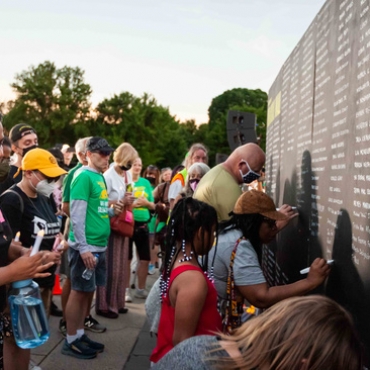Contact Admission
International Collaboration
Navigating Attacks Against Health Care Workers in the COVID-19 Era
Navigating Attacks Against Health Care Workers in the COVID-19 Era
JAMA. 2021;325(18):1822-1824. doi:10.1001/jama.2021.2701
Aweek and a half after Chicago’s COVID-19 lockdown began in 2020, a nurse on a bus ride home from her hospital shift felt the brunt of the pandemic. But it didn’t come in the form of treating an onslaught of patients with SARS-CoV-2—she hadn’t been assigned to care for those infected with the novel coronavirus.
Charlie Riedel/AP Images
On the bus, while wearing a mask, the nurse coughed into the crook of her arm. Immediately, another passenger accused her of trying to infect him. She assured him that wasn’t the case and apologized. But as he exited the bus, the man made a fist and punched her in the left eye.
The nurse told the local ABC affiliate that she’d been dressed in scrubs, told the man she’s a nurse, and worried that the well-publicized lack of personal protective equipment had made people wary of health care workers. “[I] think the concern is that any health care provider is contagious themselves,” the nurse said.
She isn’t alone as attacks against health care workers—already frequent targets for physical and verbal assaults—have evolved during the COVID-19 era.
“Anecdotally, when I talk to my colleagues and in particular the nurses and the techs, they feel like there has definitely been an uptick in the violence against them,” Terry Kowalenko, MD, professor and chair of emergency medicine at the Medical University of South Carolina in Charleston, said in an interview.
Stigmatized, Ostracized, Harassed
Violence against US health care workers has been on the rise for at least a decade. According to US Bureau of Labor Statistics data, the incidence of violence–related health care worker injuries has increased by 67%, from 6.4 per 10 000 full-time workers in 2011 to 10.7 per 10 000 in 2018. Also in 2018, health care and social service workers were 5 times more likely to experience workplace violence than all workers, comprising a whopping 73% of all nonfatal workplace injuries and illnesses requiring days away from work.
The International Committee of the Red Cross (ICRC) has compiled data on COVID-19–related attacks against health care workers in various parts of the world. During the pandemic’s first 6 months, 611 incidents of COVID-19–related physical or verbal assaults, threats, or discrimination were directed toward health care workers, patients, and medical facilities in more than 40 countries, according to the ICRC. In March, the ICRC reported that 32% of the 325 violent incidents targeting health personnel and facilities in Colombia in 2020 were pandemic related.
In a guide it published to help health care personnel and policy makers reduce or prevent attacks against health care workers, the ICRC echoed the Chicago nurse’s sentiment. Despite vast expressions of public support and gratitude for their work, the guide noted “alarming incidents of health workers being stigmatized, ostracized, harassed or threatened for allegedly spreading the virus.”
Besides assaults on public transportation, the World Health Organization has described health care workers being spat on, called derisive names like “contagious rat,” and having personal property vandalized or their children mistreated by classmates.
An Array of Attack Strategies
During the pandemic, a variety of situations appear to have promoted attacks against health care workers. A National Nurses United survey in late 2020 of more than 15 000 US registered nurses showed that about 20% of participants said they faced increased on-the-job violence, which they attributed to COVID-19–related staffing shortages, changes in their patient population, and restrictions for visitors.
COVID-19–related physician abuse also extends into the virtual realm, academic hospitalist Vineet Arora, MD, MAPP, the Herbert T. Abelson professor of medicine and assistant dean for scholarship and discovery at the University of Chicago Pritzker School of Medicine, said in an interview. A prepandemic survey she carried out with colleagues in 2019 showed that 23% of 464 US physicians said they had been personally attacked on social media.
“We don’t have data postpandemic, but we have seen the general response on Twitter and other platforms,” Arora said. “One can imagine that, given the amount of advocacy that physicians have participated in online, [abuse] is a pretty routine occurrence. If you post or Tweet about masks or vaccines, you are almost guaranteed to get a response,” she noted, adding that she believes the problem has worsened during the pandemic.
In a study published in late 2020, researchers from the University of Rochester School of Medicine and Dentistry in New York surveyed 7411 adults in 173 countries to learn more about how pandemic-related bullying and stigma have differed among health care workers compared with other people in their community.
After adjusting for factors including not being able to work from home, having had COVID-19, and not having practiced social distancing, the researchers found that health care workers were about 50% more likely than others to have been harassed, bullied, or hurt as a result of COVID-19.
In the study’s qualitative analysis, a participant in Central America said her sister-in-law, who worked in a hospital but wasn’t a physician or a nurse, was attacked in the street while wearing her surgical clothes. A male nurse in Southeast Asia said he was barred from entering a supermarket because of his occupation. In South Asia, a participant said physicians had been asked to leave their apartment buildings.
The American Medical Association (AMA) in October 2020 weighed in on another form of abuse against physicians: misinformation that they are deliberately inflating COVID-19 case counts to increase their income. “Rather than attacking us and lobbing baseless charges at physicians, our leaders should be following the science and urging adherence to the public health steps we know work—wearing a mask, washing hands and practicing physical distancing,” AMA President Susan R. Bailey, MD, said in a statement.
Verbal and psychological abuse can be just as damaging as physical violence, leading to depression, burnout, high turnover, and even suicide among health care workers, Judith E. Arnetz, PhD, MPH, professor and associate chair for research in the family medicine department at Michigan State University’s College of Human Medicine, said in an interview.
COVID-19, Arnetz noted, has created a health care environment “ripe for aggression and violence. You take it out on those who are trying to help your loved ones.”
Kowalenko agreed. He recalled a patient seeking narcotics who said he knew the emergency department (ED) shift ended at 11 pm and he would be waiting for Kowalenko in the parking lot. “I decided to do a lot of charting and didn’t leave until 1 AM, and I had security walk out with me,” he said. “It was one of the most frightening incidents in my career.”
The Importance of Reporting
Addressing health care workplace abuse and violence is an undertaking as complex as the problem itself, Kowalenko said. “There is no one silver bullet, it’s multifactorial.”
The first step is to get health care workers to report abuse and violence, Kowalenko said. “We know underreporting is a huge problem. Some studies have shown 60% of violence is not reported in any way, shape or form,” he noted.
Educating workers about what constitutes violence is crucial, Kowalenko explained. Essentially, the rule of thumb is that if you wouldn’t let someone do it on the street you shouldn’t accept it in the clinic, and it should be reported even if perpetrated by people who cannot help themselves. “A lot of violence is underreported because the perpetrators are suffering from dementia or are confused, so people tend to not report it,” he said. “The same thing happens with smaller kids.”
Reporting is key to addressing abuse and violence because it shows when, where, and how incidents take place, Arnetz said. “Reviewing data collected is the best way to learn what went wrong and what we can do to avoid it going forward.” Her studies of workplace violence include the first randomized clinical trial of an intervention aimed at reducing violence by patients against hospital health care workers. One of the findings from the Detroit Medical Center system was that most incidents took place after 8 pm. Enforcing visiting hour limits immediately reduced the incidence and severity of assaults.
The finding also illustrates the importance of having consistent policies and enforcing them uniformly. “If one nurse lets in 5 visitors and another just 2, the inconsistency can escalate people,” Kowalenko said.
Arnetz’s research also revealed that restricting patients in any way such as denying visitors or not letting them get up and walk around, being in pain, transfers, and needles can trigger violence. “Even those who don’t express fear can become surprisingly aggressive when needles are involved.”
Training staff to recognize when patients are likely to become violent and how to deescalate them are other critical skills, Kowalenko noted. A raised voice or aggressive tone, pacing, or aggressive actions are warning signs. Talking calmly about what’s bothering the patient is an effective approach when emotions run high. “The best way to reduce violence is to avoid it altogether,” he said.
Equipment as Potential Weapons
What health care personnel see as necessary medical equipment can be viewed by patients or visitors as weapons, said Jimmy Choi, MD, an emergency physician and martial arts trainer who runs San Francisco–based My Occupational Defense, a firm specializing in training health care workers to defend themselves against physical assaults. As a safeguard, wheeled intravenous (IV) poles have been replaced by poles attached to beds in many facilities around the country. Smaller items including oxygen tanks, scissors, scalpels, and IV needles—anything that can be used to strike or pierce—should be stored out of easy reach of patients and visitors when possible.
Furniture arrangement is another strategic element, Choi said. Beds should be positioned so they don’t trap staff inside the room. “Never let the patient get between you and an escape route,” he noted.
Physical self-defense training, such as how to avoid or disengage from being grabbed or choked, as well as simulated active shooter training, which focuses on when and how to run, hide, or fight, can be valuable, Choi said. He recommended finding trainers with health care backgrounds, who understand the specific needs of health care violence control.
Knowing how to safely subdue violent patients is an important skill. “When you have a big scrum is when the most harm occurs,” Choi said. Defending oneself or restraining a patient without injuring the patient requires more skill than simply disabling an attacker without regard to their safety, said Kowalenko, who, like Choi, has extensive experience in martial arts. “They are still our patients, after all,” Choi added.
He also advocated for joint training of security officers and clinical personnel on their respective roles in controlling or restraining violent patients. “It should run like a code,” he said. “Every person on the team should know their role and do it.”
Metal detectors can help avoid weapons being carried into the ED or other hospital areas. However, they’re not effective for patients brought in on gurneys and aren’t always practical, Choi said.
Cameras and panic buttons can provide added security measures, but they must be monitored to be effective. Ranya Habash, MD, medical director for technology innovation and assistant professor of ophthalmology at the University of Miami’s Bascom Palmer Eye Institute, noted a 2019 incident in which a nurse practitioner was beaten and left on the freezing ground for 2 hours before being discovered in the parking garage of a Milwaukee hospital. The initial assault, by a former valet at the garage, was captured on surveillance video. The nurse died of her injuries.
Technological Solutions
Sophisticated technology can help keep watch, said Habash, also the chief medical officer for Everbridge, a technology firm that offers health care safety systems. Solutions include panic buttons that can be downloaded onto any desktop computer or mobile device, including smart watches. They can be programmed to interface with security, local 911, incident command centers, or anyone with a smartphone.
Some systems include an escort feature that users can activate when they set out for their vehicle and deactivate when they safely reach it. If they don’t, the system asks for confirmation of safe arrival and alerts security to the employee’s location if there’s no answer. In the event of security breaches in progress, software also can warn users to stay clear of endangered areas and provide real-time video and audio intelligence inside active shooter or hostage situations, Habash said.
There’s no panic button for cyber abuse, though. Arora recommended reporting threats of violence or stalking to police. For day-to-day misinformation, nasty responses, and trolling, she suggested joining with other physicians and personnel including nurses to educate and advocate for evidence-based mitigating solutions on social media. One local group she belongs to is the Illinois Medical Professionals Action Collaborative Team, or IMPACT4HC, which developed a tool kit to help health professionals take action if they’re harassed on social media. She’s also a #medtwitter influencer.
“When I am being attacked, the community comes to my aid,” Arora said. The support counteracts the very real effects of negative comments. “It can take a toll on your mental health,” she said, suggesting that it can help to lurk on forums before posting to get a sense of how they work and what to expect. But sometimes the best strategy is to ignore and block offensive senders and move on, she said.
Arnetz noted that many other resources are available to help health care facilities develop a violence prevention and mitigation program. The Centers for Disease Control and Prevention has recommendations for limiting COVID-19–related violence and the Occupational Safety and Health Administration offers violence prevention guidelines specifically for health care workers. The Joint Commission has also weighed in.
Arnetz’ research has suggested that in units with more regular episodes of violent behavior, including EDs and locked behavioral units, workers often have skills for dealing with those encounters, although they usually can be improved. “But what about ICUs [intensive care units] and med-surg? They may not have those skills, and they can be very important when situations develop,” she said.
Source:https://jamanetwork.com/journals/jama/fullarticle/2779310?guestAccessKey=f50d7fbc-4a91-4d6f-93d3-36ae7f8d5c97&utm_source=silverchair&utm_medium=email&utm_campaign=article_alert-jama&utm_content=etoc&utm_term=051121
Other library
- One in 10 People Who Had Omicron Got Long COVID: Study ( 20:25 - 01/06/2023 )
- Physical Medicine Academy Issues Guidance on Long COVID Neurologic Symptoms ( 09:58 - 19/05/2023 )
- Breakthrough' Study: Diabetes Drug Helps Prevent Long COVID ( 08:55 - 15/03/2023 )
- BCG vaccine (thuốc chủng ngừa bệnh lao) & SARS-CoV 2 (covid-19) infection ( 10:08 - 27/10/2022 )
- Đại dịch COVID-19 đã kết thúc? ( 09:11 - 22/09/2022 )
- Dị hình giới tính ở COVID-19: Ý nghĩa tiềm năng về lâm sàng và sức khỏe cộng đồng ( 09:22 - 19/03/2022 )
- COVID-19 Update ( 21:00 - 06/03/2022 )
- Một người có thể tái mắc Covid-19 bao nhiêu lần ?? / kèm 6 tài liệu mới ... do "waning immunity", xảy ra ≥6 tháng sau chủng ngừa hay mắc nhiễm .. ( 20:25 - 06/03/2022 )
- T-cells from common colds can provide protection against COVID-19 - study ( 08:25 - 11/01/2022 )
- Coronavirus Can Spread to Heart, Brain Days After Infection ( 07:56 - 30/12/2021 )


















